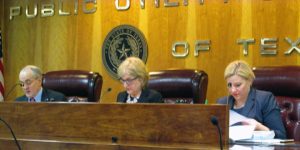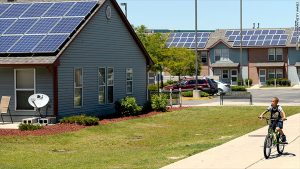
By Michael J. Jewell, Jewell and Associates, PLLC
Residential and small commercial customers who install solar generation behind their meters—commonly called “rooftop solar” or, more generically, “distributed renewable generation”—may be excused for feeling paranoid. In many cases, their electric utilities are out to get them.
While some electric providers, like Austin Energy and City Public Service of San Antonio, have shown a desire to work with customers who want to install rooftop solar, others have not been as accommodating. Why? Perhaps it is because, as one utility executive put it, customers who install solar have become the utilities’ competitors. The resulting conflicts have centered on what utilities can charge their customers who install rooftop solar and how much the utilities should pay for excess energy put onto the electric grid by a customer’s generation system.
These discussions have really taken off over the past few years, and we have seen this issue arise more frequently in electric utility cases filed at the Public Utility Commission of Texas (PUCT). As the representative of several clean energy clients, I have had a front-row seat for many of the recent proceedings.
El Paso Electric Company
In August 2015, El Paso Electric Company (El Paso) filed a rate case (Docket No. 44941) in which it proposed a new tariff that would affect only residential customers who installed on-site renewable generation. That tariff would have separated these customers into their own rate class and added a demand charge to the two-part rate structure (customer charge and volumetric energy charge) paid by all other residential customers.
EL Paso was not able to provide current customers with historical information to help understand the new demand charge or real-time information to aid them in managing their demand. This lack of clarity would especially affect potential solar customers when sizing a new PV system. The case ultimately was settled in 2016, and El Paso agreed to withdraw its proposed tariff.
 SWEPCO
SWEPCO
Later that year, Southwestern Electric Power Company (SWEPCO) filed a rate case (Docket No. 46449) in which it proposed to increase the monthly fee applicable to all customers who had or would install on-site renewable generation. Moreover, the company proposed a significant reduction in the ability of a new customer to benefit from their solar production: they planned to eliminate net metering for future rooftop solar customers by charging the full retail rate for electricity delivered to the customers, but paying the customers for energy they delivered back to SWEPCO at a much lower avoided-energy rate, with no further monthly netting of consumption and production. SWEPCO proposed this new approach to apply only to customers who installed rooftop solar after PUCT approval.
On September 22, 2017, the Administrative Law Judges (ALJs) that presided over the case issued a proposed order approving SWEPCO’s proposal. However, at the recommendation of PUCT Staff, the ALJs denied SWEPCO’s proposal to grandfather all existing customers, and instead allowed existing customers a brief, five-year delay in the application of this new rate structure. The PUCT has not yet ruled on the ALJs’ proposed recommendation.
Recent Developments
In 2017, three proposals were filed targeting customers with rooftop solar systems.
In February, El Paso filed a new rate case (Docket No. 46831) with a proposal that was similar to its prior attempt, but that targeted small commercial customers as well as residential customers. Along with the three-part rate structure, it also proposed mandatory time-of-use rates. This proceeding has been in settlement negotiations since late August, and we can expect an agreement resolving all contested issues to be filed soon.
 In March, Oncor Electric Delivery Company (Oncor) filed a rate case (Docket No. 46957) that proposed to impose a minimum fee for the transmission and distribution portion of a residential customer’s bill based on the amount of energy that customer consumed prior to installing their rooftop system. The minimum charge would be the lesser of a demand charge or the customer’s average monthly usage prior to the customer’s system installation date. Interestingly, the proposed demand charge would have been determined based on the customer’s highest peak demand since the most recent of (1) when they moved into their home or (2) when Oncor had installed an advanced meter at the home. With this structure, customers could be charged monthly fees based on usage habits from nearly ten years ago! Fortunately, Oncor withdrew this proposed minimum charge structure, and the Commission approved the settlement on October 11, 2017.
In March, Oncor Electric Delivery Company (Oncor) filed a rate case (Docket No. 46957) that proposed to impose a minimum fee for the transmission and distribution portion of a residential customer’s bill based on the amount of energy that customer consumed prior to installing their rooftop system. The minimum charge would be the lesser of a demand charge or the customer’s average monthly usage prior to the customer’s system installation date. Interestingly, the proposed demand charge would have been determined based on the customer’s highest peak demand since the most recent of (1) when they moved into their home or (2) when Oncor had installed an advanced meter at the home. With this structure, customers could be charged monthly fees based on usage habits from nearly ten years ago! Fortunately, Oncor withdrew this proposed minimum charge structure, and the Commission approved the settlement on October 11, 2017.
Most recently, in July 2017, Entergy Texas, Inc. (Entergy) filed a proposed tariff revision (Tariff Control No. 47460) focused directly on repealing its net metering policy for distributed energy customers with a capacity of 50 kW or less. While Entergy proposed that existing customers would keep their original rate structure, new customers who installed a renewable generation system with a design capacity of 50 kW or less would pay the full retail rate for all energy Entergy supplied to the customer, but receive the company’s lower avoided cost rate for energy delivered to Entergy, with no netting permitted. As of this writing, the PUCT has docketed Entergy’s proposed change for a hearing expected later this year.
Conclusion
It is unfortunate that many electric utilities are unwilling to recognize the full value of distributed energy. At a minimum, locally generated electricity does not incur the transmission losses or the transmission costs of electricity shipped from remote power plants. And there are plenty of other values as well. In its November 2016 Manual titled “Distributed Energy Resources Rate Design and Compensation,” the National Association of Regulatory Utility Commissioners (NARUC) recommends a more holistic approach. It suggests utilities work with their customers and stakeholders to develop a reasoned approach to the determination of the value of distributed renewables.
A more informed approach, like some Texas electricity providers embrace, would be more customer friendly and recognize the many values that utilities and their customers realize from these resources—especially when considering grid outages following major storm events like Hurricane Harvey.
Michael J. Jewell is the Principal Attorney at Jewell & Associates, PLLC. In addition to telecommunications and other electric issues, the Firm’s practice focuses on matters related to the development of clean energy including solar energy, wind energy, storage, and other resources.
